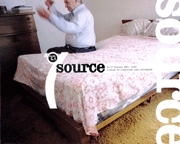Each Wild Idea: Writing, Photography, History by Geoffrey Batchen
Book Review by Justin Carville
Issue 27 Summer 2001
View Contents ▸
Each Wild Idea by Geoffrey Batchen
Published by: MIT Press
ISBN: 0-262-02486-1
Price: £23.95
In the introduction to his Trauerspiel study, Walter Benjamin defined the term 'origin' as "not intended to describe the process by which the existent came into being, but rather to describe that which emerges from the process of becoming and disappearance". Origin is thus used to describe that which is in and out of time, something that has become, yet is incomplete. This definition of origin is useful as conceptual framework to discuss Geoffrey Batchen's dual concerns in Each Wild Idea; the birth and death of photography and their respective fractured histories. Following his previous publication Burning with Desire, Batchen examines the birth of photography to understand its death, and its ultimate successor digital imaging. In this scenario the death of one watches over the birth pangs of the other. Batchen's approach to this subject however, does not incorporate the dialectical materialism of Benjamin but the philosophical deconstruction of Michel Foucault and Jacques Derrida.
In nine chapters previously published in an impressive list of journals, books and catalogues, Batchen discusses a wide range of discursive practices from the origins and the writing of photographic history Australian and vernacular photographies and the shared political economies of the photographic and digital image. Batchen's work is part of a broader project in contemporary critical inquiry characterised by a shift from history to discourse as the object of analysis. The emphasis of investigation into the origins of photography is thus shifted from the earliest example of photography, to a recurring discourse that describes a desire to photograph. This discursive practice is well known in photographic historiography, and there are other photo-historians using quite different theoretical frameworks to discuss it, Batchen stands out however as the most prolific writer in this field.
The discursivity of the origins of photography is the subject of his most widely referenced essay Desiring Production which forms the opening chapter of the book. His arguments in this opening chapter are persuasive but at times over determined in his use of deconstructive models to discuss the photographic practices of those he refers to as proto-photographers. His argument that Talbot's photographs of books, statuettes, and figurines in the courtyard of Lacock Abbey are "emblematic of the process of photographic production itself" is a case in point. The reason for Talbot's photographs of these objects can be thought about another way. Photography made it possible for the first time to reproduce and make transportable in miniature vast quantities of commodities, something the photographic image itself was to become. Talbot's photographic printing works at Reading produced prints of statuettes, art objects and documents for mass consumption and to illustrate books. The book was itself probably the first self-contained mass-produced commodity and his book photographs could be read as images of the desire for mass reproduction and consumption, a desire that Talbot actively sought to fulfil through various patents and commercial enterprises.
A point of contention that is relevant to Ireland is his dismissal through paraphrasing Foucault, of those persons that began photographic experiments after the announcement of photography as "the dull grey of what everyone at a particular period might repeat". This is a peculiar position to take given his arguments over photographic history in his native Australia. The histories he dismisses are important to those countries like Ireland whose histories of art, technology and discursive practices have been shaped by the reifying forces of colonial and post-colonial administration. These histories frequently resist the totalising narratives of dominant historical discourse and given his arguments on the need for Australian photography to be recognised for its regional qualities combined with his interest in the disparity of photographic history it is perplexing that he predictably turns to the US rather than countries with similar fractured histories as a point of reference.
The arguments are at times dismissive of alternative trajectories of photographic discourse, yet they are a highly accessible range of essays from one of the most creative and prolific writers on the photographic image from the last decade.
Other articles by Justin Carville:
Issue 24: Will the Real History of Photography Please Stand Up? [Feature] ▸
Issue 27: The History of the Solitary Lighthouse Keeper [Review] ▸
Other articles mentioning Geoffrey Batchen:
Other articles mentioning Henry Fox Talbot:
Flea Market Photobooks: Marvellous World of Shells [Web Article] ▸
Source Photo: List Mania: 2011 Photobook Roundup [Blog Post] ▸
Other articles on photography from the 'Historical' category ▸





